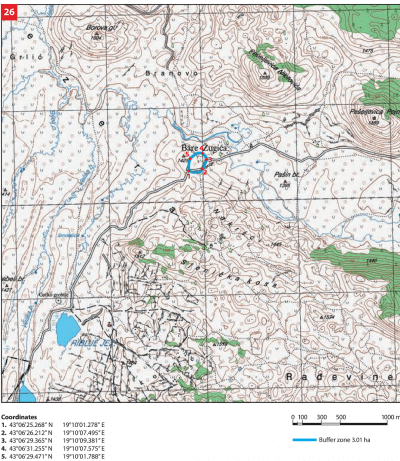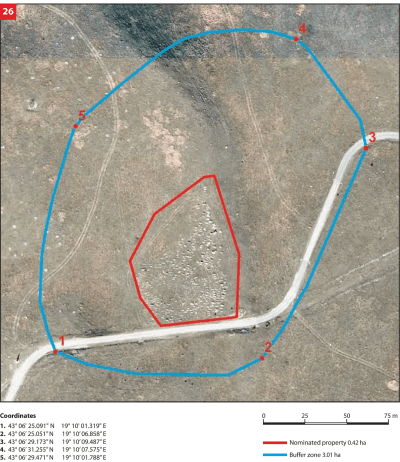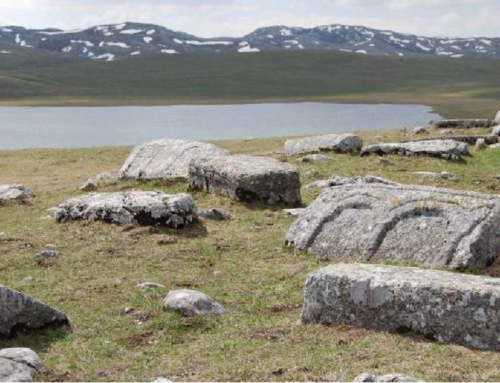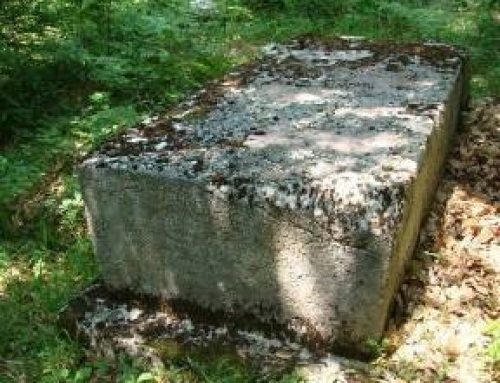About

The necropolis is located in the contact zones of the Durmitor National Park (1952), the Tara River basin as a World Biosphere Reserve (UNESCO, 1977) and the Durmitor National Park with part of the Tara River Canyon (inscribed on the UNESCO’s List of World Natural and Cultural Heritage in 1980). It is situated in the hamlet of Novakovići, around 2,230 meters to the northeast of the Grčko groblje necropolis (25). On the southern side is the local Novakovići – Njegovođa road and across the road there is a church with the local cemetery. The necropolis was formed on a slightly elevated ground.
It has 300 stećci of which 10 slabs, 50 chests, 10 gabled roof tombstones and 230 amorphous blocks. Stećci of fine workmanship are located in the northern and the central part of the necropolis whereas most of the amorphous ones are located in the southern and south-east parts. All stećci are laid in rows and east-west oriented.
A total of 23 tombstones are decorated: 1 slab, 16 chests and 6 gabled roof tombstones. The most common motifs include: bands, frames and edgings with slanting tiny lines, plain and twisted bands, plain and stylized crosses and bows with arrows.
There is a smaller number of arcades, twining vines with trefoils, three concentric circles connected with a ribbon, rosettes, crescents, sword and shield. There are also horizontal decorations with zigzag lines, vegetal stylization and a sphere. One depicts the scenes of wheel dancing, a dog with a deer and the original wheel dancing with mounted deer.
No inscriptions have been recorded.
Like the previous one, the necropolis Bara Žugića is located in the area of Jezera (lakes) and the ancient Drobjak tribe. Given that these two necropolises are situated in the same area of the Durmitor Mountain, we assume that their cultural and historical development was identical. The first phase of development of the site can be identified as the period of the Middle Ages and the tradition of ancient communications. The second period of duration and development of the necropolis refers to its stagnation and closedown during the long reign of the Ottoman Empire in that and other areas from end 15th to end 19th century and the effect of liberation aspirations and wars of the population in the areas of Drobnjak, Uskok, Jezera, Šaranac and others, especially Herzegovina areas. In the immediate vicinity is a road leading from Žabljak to Njegovuđe and undeveloped areas used for traditional economy, meadows for livestock grazing and Riblje jezero for cattle to drink water.
During the 20th and at the beginning of this century, the necropolis Grčko groblje on the Durmitor mountain was not subject to significant changes, except for the effects of weather and natural conditions. Montenegro has preserved the traditional opinion and practice under which old cemeteries are not to be destroyed and deserve particular respect. They are often the subject and motive of dating in the distant past of population and of mythical and legendary stories of the people who had lived in these areas. Therefore, stećci as grave markers had been spontaneously preserved in Montenegro until the institutional establishment of the institution for protection of cultural heritage of Montenegro in 1948. Since then, a number of necropolises and individual stećci have been registered and protected, while a large number has been expertly analysed in literature dealing with this segment of cultural heritage.
The necropolis with stećci has not been subject to archaeological excavations and investigation nor has it been treated by applying conservation and restoration procedures. The necropolis Bara Žugića on the Durmitor Mountain was protected as a cultural monument of national importance in 2012, following partial research works and corresponding documentation from the 1960-ies as well as in the last three years.
Location
The northern boundary of the necropolis is defined by grassy flat mead ending with a sharp slope, while the southern and eastern boundaries are defined by a local road. The western boundary is defined by a gentle slope covered with low vegetation ending at the bottom of a mildly elevated terrain.
State of the location
The necropolis entirely kept its original position and contents, because there have been no human interventions (in terms of constructing new facilities) since the time when the practice of burials under the stećci was abandoned. Due to the very position of the necropolis, on a naturally elevated terrain with no vegetation, tombstones are exposed to the wind and impact of precipitations especially pronounced in this mountain area. Due to natural and climate factors, the stećci were either moved or turned over from their original base. They were mostly thrown down towards the south due to strikes of northern winds, due to which only a few massive and high stećci remained at their original place, unlike the shorter slabs and gabled roof tombstones, which are still in their original place. The same factors caused cracks in the stone and, to a greater or lesser extent, the appearance of different types of lichen and moss. Low temperatures during the winter and a huge quantity of precipitations, snow and rain turn water into ice, which in time increases its volume and destroys the monolith, increasing the apertures and cracks. To date, the necropolis has not been archeologically excavated or anthropologically researched. In 2010, an archaeological field survey with relevant documents and geodetic survey were performed, and an architectural plan of the necropolis with the buffer zone was developed. In 2012, a research was conducted from the aspect of establishing legal protection of the site, and documentation was supplemented on that occasion with the description of the state of each tombstone, thus creating a basis for the development of a conservation project and proceeding with conservation measures, in accordance with relevant legislation regulating cultural property protection.
FAQ
Facilities for visitors and infrastructure
The necropolis Bara Žugića is located in the eponymic hamlet of the village of Novakovići, along the Žabljak-Njegovuđa asphalt road and it gravitates towards the municipal and only urban centre of Žabljak. Tourism here has mainly a transit character, except for the winter period when tourist capacities and services such as ski trails, ski lifts, small hotels and private accommodation are used to a considerable extent.
Žabljak has the highest mountain tourism potential in Montenegro, consisting of Durmitor mountain and national park, glacial lakes, diverse flora and fauna, cultural heritage and seasonal events. Tourist capacities (hotels, private accommodation, availability of tourist information, catering services, etc.) and tourist programmes (sports and recreation, health, entertainment and leisure, food and drink, cultural heritage, etc.) are available and accessible and relatively close to this necropolis. The necropolis Bara Žugića is not included in the tourist offer, there are no signs directing to it nor are there any other types of informative or promotional support.
For the purpose of improving tourist valorisation, it is necessary to plan, design and build all necessary infrastructure (pedestrian and biking trails, parking lot, sanitary facility) in the appropriate place. It is necessary to put adequate signs along the roads. At the same time it is necessary to train new or existing staff dealing (or envisaged to be dealing) with the management, presentation and promotion of cultural heritage. Continuous work has been envisaged on improving the conditions of stay and accommodation for potential tourists of various profiles.



